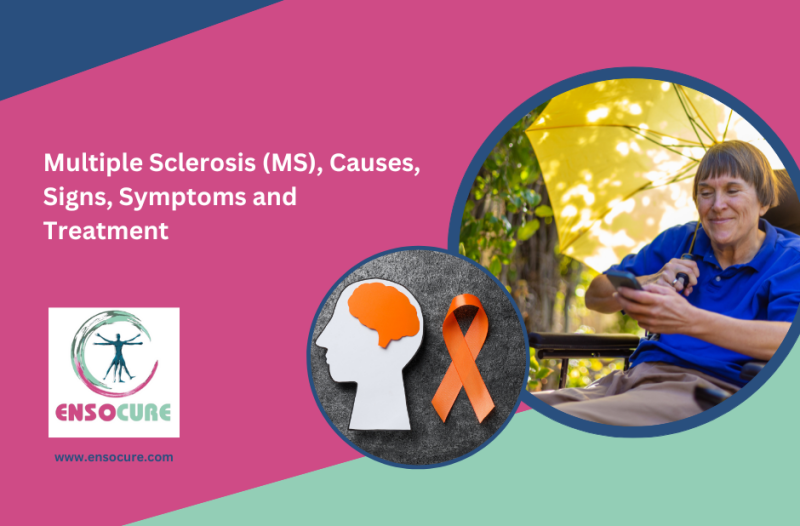Multiple sclerosis is an autoimmune disease that attacks your central nervous system, damging nerves leading to symptoms like fatigue, difficulty in walking, and speech difficulties. Currently, there is no cure for this condition, but there are various treatments to help manage its symptoms.
What Happens in Multiple Sclerosis

In MS, the immune system mistakenly attacks the protective covering of nerve fibers, called myelin. It can also damage the underlying nerve fibers and cells leading to scarring and lesions that disrupt the normal flow of electrical impulses in the brain. The exact cause of MS is not fully understood, but it is believed to involve a combination of genetic and environmental factors. This is what happens in MS.
- Inflammation: The immune system’s T cells, which are normally responsible for defending the body against infections, enter the CNS and trigger an inflammatory response. This inflammation leads to the formation of lesions or plaques, primarily in the white matter of the CNS.
- Demyelination: The inflammation damages the myelin sheath that surrounds and protects nerve fibers. Myelin acts as an insulator, allowing nerve impulses to travel quickly and efficiently along the nerve fibers. When myelin is damaged or destroyed, nerve signals are slowed down or blocked.
- Axonal damage: In addition to demyelination, the nerve fibers (axons) themselves may be damaged or destroyed in the process. This can result in a loss of function in the affected nerves.
- Scar tissue formation: As the immune response subsides, scar tissue (sclerosis) may form in the areas where myelin was damaged. This scar tissue can further interfere with normal nerve function.
Types of Multiple Sclerosis
The different types of MS include:
Clinically isolated syndrome (CIS): A Pre-MS condition with symptoms lasting over 24 hours due to CNS demyelination. While indicative of MS, CIS alone doesn’t confirm a diagnosis.
Relapsing-remitting MS (RRMS): Characterized by clear disease activity relapses followed by remissions. Symptoms are mild or absent during remission, with slight to moderate disease progression. RRMS is the most common initial form of MS accounting for 85% of cases as per NMSS.
Primary progressive MS (PPMS): Marked by progressively worsening neurological function from symptom onset, although short stability periods may occur.
Secondary progressive MS (SPMS): This form evolves from RRMS, featuring noticeable relapses and a gradual increase in disability or function decline.
Causes of Multiple Sclerosis
MS is not directly hereditary, but having a family member with MS slightly increases the risk. Certain genes identified in a review of studies seem to make individuals more prone to developing MS.

Genetics: There is a genetic component to MS, as individuals with a first-degree relative (parent, sibling, or child) who has MS have a slightly higher risk of developing the disease. However, MS is not directly inherited, and specific genes associated with MS susceptibility have been identified.
Immune system dysfunction: MS is considered an autoimmune disease, where the immune system mistakenly attacks the central nervous system (CNS), including the brain and spinal cord. The exact trigger for this immune response is not fully understood.
Environmental factors: Certain environmental factors may contribute to the development of MS. Some potential factors include:
- Viral infections: Some viruses, such as the Epstein-Barr virus (EBV), have been associated with an increased risk of developing MS. However, the relationship is complex, and not everyone with an EBV infection develops MS.
- Vitamin D deficiency: There is evidence suggesting a link between low levels of vitamin D and an increased risk of MS. Adequate exposure to sunlight, which helps the body produce vitamin D, may have a protective effect.
- Smoking: Smoking has been identified as a modifiable risk factor for MS. Individuals who smoke are at a higher risk of developing MS compared to non-smokers.
- High body-mass index during adolescence: According to research, a high BMI during adolescence can increase the risk of MS as much as 16 times that of the general population. This is especially if one has a genetic disposition to MS.
- Gender and age: MS is more common in women than men, and it often begins between the ages of 20 and 40. The reason for this gender difference is not fully understood. RRMS is more prevalent in women, whereas primary progressive MS (PPMS) affects both genders equally. Generally, MS is believed to be more aggressive in men, with often incomplete recovery from relapses.
- High cow’s milk consumption as a child and adolescent: As strange as it sounds, some research has linked cow’s milk consumption to MS for a long time. Immune cells in those with MS can target dairy proteins (butyrophilin and MOG) due to their structure being like myelin. Dairy is also full of saturated fat which has been linked to the risk of MS progression. This is why researchers usually recommend avoiding cow’s milk in MS.
Signs and Symptoms of MS
MS can either manifest suddenly or so subtly that the symptoms are easily overlooked. Common early symptoms include:
- Unsteady balance and weakness in the legs, leading to frequent tripping during physical activities.
- Numbness and tingling in the arms, legs, or one side of the face, similar to the sensation of a limb “falling asleep” but occurring spontaneously.
- Vision issues like double vision, blurry vision in one eye, or partial vision loss are sometimes accompanied by eye pain.
These early symptoms can disappear and reappear in 80% of patients over time, with intervals ranging from weeks to years between flare-ups. However, these symptoms can be caused by various conditions, so their presence doesn’t necessarily confirm MS. A complete list of symptoms includes:
- Fatigue
- Vision problems
- Balance issues
- Numbness and tingling
- Muscle spasms, stiffness, and weakness
- Mobility problems
- Pain
- Problems with thinking, learning, and planning
- Depression and anxiety
- Sexual problems
- Bladder control issues
- Sleep disturbances
- Tremors
- Bowel problems
- Speech and swallowing difficulties
Diagnosing Multiple Sclerosis (MS)
To diagnose Multiple Sclerosis, a neurologist typically conducts a neurological examination, reviews clinical history, and prescribes a series of tests. These tests might include:
- MRI scans, which use contrast dye to detect active and inactive lesions in the brain and spinal cord.
- Optical coherence tomography (OCT) for imaging the nerve layers in the eye, checking for optic nerve thinning.
- Spinal taps (lumbar puncture) to detect abnormalities in spinal fluid and help rule out other infectious diseases. This test also looks for oligoclonal bands (OCBs) indicative of MS.
- Blood tests to exclude other conditions with similar symptoms.
- Visual evoked potentials (VEP) test to measure electrical activity in the brain in response to nerve pathway stimulation.
For an MS diagnosis, evidence of demyelination at different times in multiple areas of the brain, spinal cord, or optic nerves is required. Demyelination hinders efficient signal transmission in nerves. Additionally, other similar-symptom conditions like Lyme disease, lupus, and Sjögren’s disease must be excluded.
Living with Multiple Sclerosis
Predicting the progression of MS in individuals is challenging. However, life expectancy among those with MS has been increasing. Approximately 10 to 15% of individuals with MS experience minimal disability and rare attacks a decade post-diagnosis, often referred to as ‘benign MS.’

The progression of progressive MS is usually quicker than relapsing-remitting MS (RRMS). Those with RRMS can experience extended periods of remission. A lack of disability after five years is often a positive indicator for the future.
Men often experience more severe and debilitating forms of the disease, as indicated by a 2018 review of studies. The quality of life with MS depends on the individual’s symptoms and their response to treatment. Although MS can change course unpredictably, it is rarely fatal, and most individuals with MS do not become severely disabled, leading full lives. Individuals with Multiple Sclerosis (MS) often find effective ways to manage their symptoms and maintain a good quality of life.
MS Treatment and Management
While no cure exists for MS, several treatments are available to manage symptoms and improve life quality.
Disease-modifying therapies (DMTs)
These are meant to slow MS progression and reduce relapse rates. DMT includes self-injectable medication self-injectable medications like glatiramer acetate, beta interferons and ofatumumab (Kesimpta). Oral medications for MS in India include dimethyl fumarate, Dalfampridine, Fingolimod, Ocrelizumab, natalizumab and others.
Corticosteroids like methylprednisolone and Acthar Gel are prescribed for relapses, alongside other treatments targeting specific symptoms. Treatment plans for MS are personalized, depending on individual symptoms, and require a flexible approach. DO NOT SELF MEDICATE AND ALWAYS CONSULT A DOCTOR.
Physical Activity
Regular exercise is vital for both physical and mental well-being, even for those with disabilities due to MS. Activities like swimming or specialized yoga classes can be beneficial for those who find physical movement challenging.
Diet
A nutritious diet is key to managing overall health. This diet should include a variety of fruits and vegetables, lean proteins like fish and skinless poultry, whole grains, nuts, legumes, low-fat dairy products, and sufficient hydration. Avoiding foods high in saturated fats, trans fats, sugars, sodium, and heavily processed options is advisable.

For those with additional medical conditions, consulting a doctor about a tailored diet or dietary supplements is recommended. Learning to read food labels effectively can help maintain a nutrient-rich diet, which is beneficial for short-term well-being and long-term health. Ensocure Integrated Medicine provides counselling and nutritionist tailored diets for those suffering from chronic illness and various conditions.
3. Complementary Therapies
While research on the effectiveness of complementary therapies is limited, they can still offer benefits. Therapies like meditation, massage, tai chi, acupuncture, and hypnotherapy may help reduce stress and increase relaxation.
Key facts about Multiple Sclerosis
- MS is globally recognized as the most common neurological condition causing disability in young adults. The typical age range for those diagnosed with Relapsing-Remitting MS (RRMS) is between 20 and 50 years.
- According to the most extensive MS study called the Atlas of MS, there are 2.9 million people living with MS worldwide.
- Worldwide, at least 30,000 children and teenagers under the age of 18 years are living with MS, although this is likely to be an underestimate due to many countries still being unable to provide data.
- In India, the prevalence of MS in India has increased from 1.33/100,000 in 1985 to 20–25 /100,000 individuals in 2015. Suggesting that the number of MS patients diagnosed annually has nearly doubled.
- MS generally affects more women than men, with RRMS being two to three times more prevalent in women. Similarly, the occurrence rates of Primary Progressive MS (PPMS) are nearly equal in both sexes.
- Geographically, MS rates are lower in regions nearer the equator, possibly linked to sunlight exposure and vitamin D levels. People who move to a new region before the age of 15 tend to adopt the MS risk factors of that location, unlike those who relocate after 15. Canada reports the highest MS rates globally.
Multiple sclerosis is a lifelong condition presenting unique and evolving challenges. Individuals with MS are encouraged to maintain open communication with their healthcare providers, educate themselves about the condition, resort to self-care and find what works best for their well-being.

